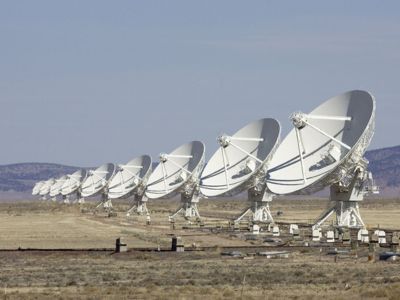Massive Radio Array Will Scan For Alien Signals - Are We Alone?
The pursuit of extraterrestrial life has taken a significant leap forward as the world-renowned National Science Foundation’s Karl G. Jansky Very Large Array (VLA) joins the quest.

The VLA’s focus is on detecting technosignatures, emissions unique to artificial transmitters, with the potential to reveal advanced civilizations beyond our own.
Situated about 50 miles west of Socorro, New Mexico, the VLA is a remarkable radio astronomy observatory, boasting 27 antennas spread across 23 miles of desert terrain. Since 2017, the VLA has participated in the Very Large Array Sky Survey (VLASS) project. Its new mission involves collecting and analyzing data during VLASS observations, using a specialized receiver to identify narrow-band components in signals from intentionally engineered transmitters and differentiate them from natural occurrences.
The SETI Institute leads this groundbreaking effort in collaboration with the National Radio Astronomy Observatory and the Breakthrough Listen Initiative. The new processing system for SETI is named COSMIC (Commensal Open-Source Multimode Interferometer Cluster).
VLA expert Paul Demorest explains, “COSMIC operates commensally, meaning it functions in the background, using a copy of the data astronomers are obtaining for other scientific purposes.”
COSMIC can identify various transmissions, such as pulsed and transient signals, while monitoring an impressive range of frequencies and examining around ten million star systems. Since 2023, COSMIC has detected signals from Voyager 1, the most distant human-made object, currently located about 15 billion miles away.
Combining the VLA’s unparalleled sensitivity with the COSMIC system makes this SETI search about a thousand times more comprehensive than previous efforts. This collaboration could potentially uncover a radio whisper, suggesting that we are not the only intelligent inhabitants of the Milky Way Galaxy.
Tony Beasley, Director of the NRAO, expressed enthusiasm for the partnership, stating, “The National Radio Astronomy Observatory is proud to partner with the SETI Institute in this exciting initiative. Partnerships that bring together world-class research instruments, private research institutes, and members of the public personally committed to forefront science can enable new important discoveries.”
As the VLA and COSMIC continue searching for extraterrestrial life, researchers and scientists worldwide eagerly await the results. Detecting technosignatures would mark a turning point in human history, transforming our understanding of our place in the cosmos and unlocking new avenues for scientific exploration and collaboration.
Even if the search does not yield immediate results, the collected data will still provide invaluable information for other areas of astronomical research. This could potentially offer new insights into galaxy formation, dark matter distribution, and enigmatic cosmic phenomena like fast radio bursts.
This partnership combines resources and expertise to enhance the likelihood of detecting technosignatures and expand our understanding of the universe. Ultimately, it aims to answer the age-old question of whether we are alone in the universe.
READ MORE
-
India Successfully Lands Spacecraft on Moon’s South Pole
India achieves a historic milestone by successfully landing Chandrayaan-3 spacecraft on the moon's south pole, marking the nation's ascent to lunar exploration. Learn about the significance of this achievement and its implications for space exploration.Read More -
Timber in Orbit: Japan’s Wooden Satellite Prepares for Launch
In a groundbreaking endeavor, Japanese researchers are challenging conventions by showcasing the unexpected resilience of wood in the hostile environment of outer space. This extraordinary feat raises an intriguing question: could wooden satellites hold the key to a sustainable future for space technology?Read More -
Seradata Welcomes Melissa Quinn: New Horizons with EVONA
Breaking: Melissa Quinn's new role unveiled - placed by EVONA. Discover her transformative journey from Spaceport Cornwall to Seradata.Read More